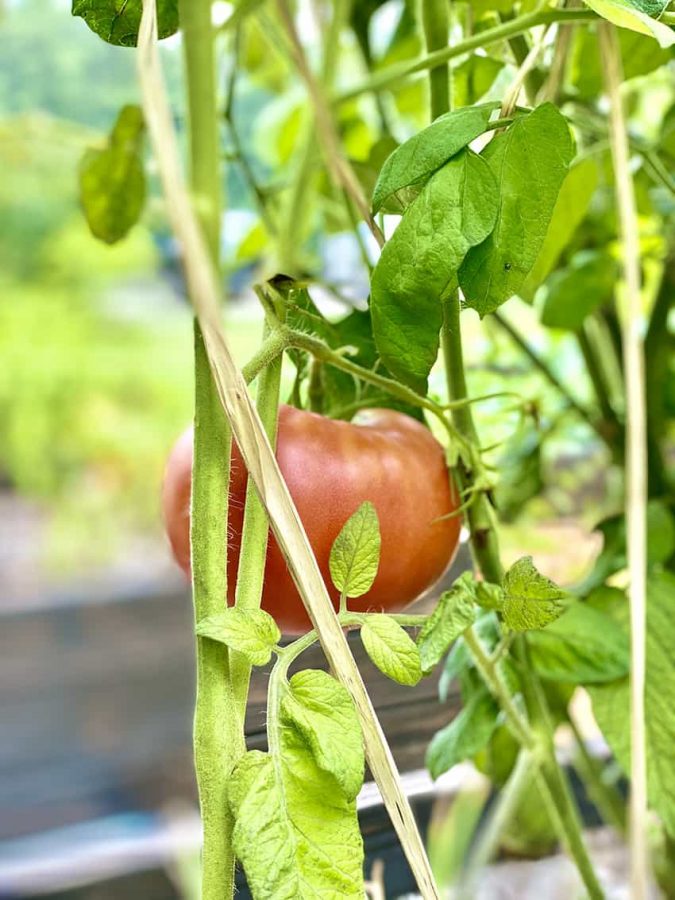Three Easy To Grow Vegetables for Your Garden
The thought of starting a garden can be intimidating, but rest assured we have a few tips and tricks that will help you succeed! Tomatoes, cucumbers, and eggplant are three of our favorite easy-to-grow vegetables that will have you wondering why the heck it took you so long to flex your green thumb.
Tomatoes are top on our list of easy to grow vegetables for the garden!


Ahh tomatoes, the crown jewel of the garden, and as far as plants go, they are pretty hardy too! This luscious fruit can be grown in your backyard garden, patio, or balcony. This means no matter how small your space is; you have enough room for this easy-to-grow vegetable in your garden.
While tomato plants are pretty hardy themselves, there are a few tips to keep in mind when planning to grow tomato plants.
- Learn the difference between determinate and indeterminate tomato plants. While tomatoes are an easy-to-grow vegetable, it is essential to understand the space you are working with and how BIG these plants can grow. If you have minimal space, look for determinate varieties of tomato that only grow to about 4 feet tall. These are neat, self-contained tomato bushes that keep to themselves and thrive in containers. These compact plants fruit all at once during the season. If you have more space to grow, opt for indeterminate varieties of tomato plants that can grow over 8 feet tall and produce fruit throughout the growing season.
- More Sun Equals More Fruit. Choose your sunniest garden spot because tomatoes soak up sunshine just like water. Tomato plants require about seven hours of sun a day, so the brighter the location, the better!
- Tomatoes need warm soil. Whether you start your seedlings or purchase them, tomatoes need lots of warmth and won’t do too much if your soil is too cool. Wait until soil temperatures are consistently over 60° Fahrenheit before planting outside.
- Plant them DEEP!!! Unlike other plants, tomatoes will form roots from each of the tiny hairs along their stems. That means you can plant them deeper, creating a stronger root system. When ready to plant, dig a trench, add a slow-release fertilizer, and lay the stem sideways, bending gently upward. Snip or pinch off the lower branches and cover with soil up to the first set of leaves. This extra root growth will produce a stronger, more robust plant.

- Companion plants are a must! Basil, garlic, and onions are a tomato’s best friends in the kitchen and the garden. Grown together, they repel pests such as nematodes.
- Get ready to water a lot! To grow big, juicy tomatoes, you will need to water those plants with about an inch of water a week. A blanket of mulch — anything from shredded pine bark to grass clippings and composted leaves — will keep the water from evaporating in summer’s heat.
- You are going to need a support system. Neat, self-contained determinate tomato plants keep to themselves but don’t even think about not supporting indeterminate tomato plants. They will grow uncontrolled, with fruit grazing the ground and possibly even breaking limbs from the fruit’s weight. Cage or stake plants early before they get out of hand.
- When it is time to harvest, pick in the morning or evening, gathering those that appear at least halfway ripe. Large heirloom varieties often ripen from the inside out and should be picked when they feel pretty firm, even if they still have green shoulders.
- Heavy rain in the forecast? Gather all almost-ripe fruits before heavy rain showers, especially cherry tomatoes. Drenching rains following periods of dry weather can cause fruits to crack.
- Tomatoes have shoulders, and you should use them for storage! Once your tomato plant starts fruiting and you begin harvesting, you will inevitably need to store some of them. Instead of storing tomatoes stem side up on the counter, which can result in a mushy/soft bottom, store tomatoes upside down on the stem so that they rest on their shoulders. The bottom of the tomato, where the blossom was, is the part of the fruit that ripens first, so if you store the fruit with all of its weight sitting on the bottom, it will begin to deteriorate faster.
Once your tomato harvest begins to come in, you will need recipe inspiration. Here are a few of our favorite ways to devour fresh tomatoes from the garden.

Homemade Bloody Mary Mix
Our recipe for Bloody Mary Mix is easy, delicious, and uses up a TON of tomatoes!

The BEST Homemade Tomato Soup
The name doesn’t lie here folks, GFree Foodie literally has the BEST tomato soup recipe on the planet. During the months that we harvest fresh tomatoes, we find ourselves enjoying this soup with sandwiches and salads quite often.
Cucumbers are another garden veggie that is top on our list of easy to grow vegetables for the garden!

Depending on the variety, cucumbers are ready for harvest 50 to 70 days after planting, that’s fast folks! Practice the tips below for a bumper cucumber crop.
- Plant cucumber plants in a raised bed, pot, or vertically on a trellis for the most delicious results.
- For the best-tasting fruit and great yields, grow plants in a sunny spot and in warm, fertile, and well-drained soil rich in organic matter. If at all possible look fpr a spot that gets earky morning sun whch will help to evaporate any dew on the plants leaves which could encourage teh growth of powdery mildew.
- Cucumber plants are heavy feeders, so be sure to feed the soil with rich compost or aged manure. After the vines develop runners and the first flowers appear, follow up with a side dressing of compost, aged manure, or fertilizer once a month.
- Cucumbers need garden friends!!! Like people, plants get by with a little help from their friends. Cucumbers need to be pollinated to produce, so plant pollinator-friendly flowers nearby. If you don’t attract pollinators, you’ll likely get cucumber flowers, but no fruit or oddly-shaped fruit.
- Different varities of cucmber need to be harvested at different times and sizes. For optimum taste and texture, American slicers are generally best when harvested at 6 to 8 inches long; Middle Eastern types such as Amira should be picked at 4 to 6 inches; most picklers at 3 to 5 inches; and Asian varieties at 8 to 12 inches.
- Let’s eat! When it is time to harvest, simply grasp the fruit and cut the stem with a pruning or kitchen shears a quarter-inch above it. You can keep harvested cucumbers in the refrigerator for 7 to 10 days although their texture will begin to deteriorate.The more you harvest, the more fruits your cucumber plant will produce, so keep picking ’em!
Once your cucumber plant begins to produce fruit, you will need recipe inspiration. Here is a delicious way to devour fresh cucumbers straight from the garden.

Cucumber Limeade Popsicles
This Mess is Ours‘ popsicles are a refreshing blend of fresh cucumber, lime juice, and ginger, all sweetened up and frozen into a refreshing pop that will not only help you beat the heat but is irresistibly delicious too!

Simple Cucumber Salad
This cucumber forward recipe from GFree Foodie is packed with crunchy, fresh-from-the-garden flavor. It’s one of our favorite gluten-free side dishes to make during the summer, a great companion to grilled meats, fish or pasta.
Eggplant is an easy to grow garden vegetable that doubles as eye candy!

There are all sorts of sizes and shapes of eggplant you can grow in your garden! From larger varieties like Globe eggplants to smaller container varieties that only grow to about the size of a tennis ball, there is an eggplant variety for everyone.
- Like petite cherry tomatoes are easier to grow than tomato varieties with huge fruits, eggplant varieties that produce modest-size fruits are the most trustworthy types for gardens. Long, slender Asian varieties and container varieties are the easiest to grow by far.
- Pollinators are encouraged but not required for eggplants! Self-fertile eggplant flowers can be fertilized by wind alone, but buzz-pollination by bees improves fruit set and size. If pollinators are absent or you have only a few plants, you can hand pollinate them by dabbing a dry artist’s paintbrush in the open blossoms. Or, touch the back of the flowers with a vibrating toothbrush to simulate a visit from a buzzing bee.
- Harvest eggplant when fruits stop growing, and their skin becomes glossy. Remove ripe fruit with gardening shears, leaving a small portion of the stem attached.
Once your eggplant begins to produce, you will need recipe inspiration. Here are a couple delicious way to devour eggplant!

Caponata of Eggplant
This sour meets sweet oven-roasted relish is perfect on crostini, cheeseboards, or as a side dish on its own. It uses a bevy of garden veggies all at once and preserves them for just a little while longer.

The Ultimate California Grown BLT
It is hard to improve upon the classic BLT, but we think our Ultimate California Grown BLT Sandwich has a good chance of stealing your heart forever! From its luscious eggplant bacon weave to its grilled asparagus and pistachio pesto this BLT will have you declaring love at first bite.
Did you know California provides most of the nation’s nursery plants?
It’s true! And they help keep our ecosystem healthy. In fact, nursery plants provide forage and habitat, clean air, regulate humidity and support a healthy environment. Learn more at Plant California.
Interested in learning about more gardening projects? Check out the posts below!

How to Plant a Cocktail Themed Container Garden
Gardeners limited to a balcony, a small yard, or only a patch of sun on their driveway can still get creative with their crops by designing a cocktail-themed container garden inspired by their favorite beverage!

Building Raised Garden Beds
Ever dreamed of building garden beds? You can read all about the process and you may even find some inspiration on this how-to post for the garden.

